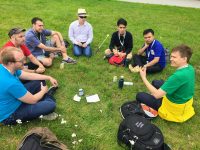Today is the International Day of the World’s Indigenous Peoples, a day that the United Nations started in December 1994 to strengthen the rights of indigenous groups around the world. Through our work with many indigenous language speakers, we also get to learn about the challenges that communities face. Those learning and our work with them help co-create initiatives to address some of the most pressing challenges—OpenSpeaks and the Marginalized Community Council are two such initiatives that were born because of such works. When we share our gratitude to the elders and friends from several marginalized communities that have embraced us, and have shared their words of wisdom with us, we would like to share the same with or readers and activist friends in the form of some recommendations.
Recommendations for the growth of indigenous, endangered and other marginalized languages:
- Critical knowledge production in a marginalized language:
Many native speakers around the world and particularly in India naturally tend to contribute literary content when it comes to creating content in their own languages. Creative writing is useful for a language as people that have a shared culture could relate to their native language literature to their own identity. However, creation of critical knowledge in the domains of science, technology, engineering and mathematics (STEM) are generally skewed in most marginalized languages and could be given a higher priority. Similarly, documentation of factual information should be widely encouraged. All of these help the readers to receive knowledge of many different domains. - Creation of digital media and widespread use of the language on the Internet:
Most marginalized languages are limited to only oral knowledge. Unfortunately, multimedia and the digital forms of communications including the Internet dominate the economy today. It is important for a language to have a critical mass of users who use their own writing system (script/alphabet) while sharing anything in their language. Harnessing the frugal technology like using smartphone and mobile data to create digital media is highly recommended to grow the use of a marginalized language on the Internet. - Critical technical infrastructure and capacity building:
Every language is unique and there is a need to create technical resources like input tools for mobile apps, language learning tutorials and even digital games, among other technical resources. Creating such resources wil help users of all walks of life to make use of their language digitally. However, this is still half the job done. What really needs to be done is to build educational resources and active outreach for capacity buiding. Social media is a great way to engage with a target audience and do that.
We’re building a working group—Marginalized Community Council—where key stakeholders contributing to activism, community engagement and resource building for marginalized communities. Check more!




